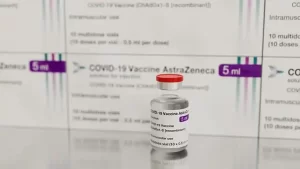Statins increase the metastatic ability of cancer cells but reduce their colonization ability
- Global First: Bovine Avian Influenza Transmission to Humans Detected
- Potassium-Enriched Salt Substitutes: Reducing Blood Pressure Risk?
- Tritium Detection in Fukushima’s Seawater: Below Safety Standards
- What Reason Let AstraZeneca Withdraws COVID Vaccine From The Market?
- How Many Times Can a Cancer Patient Undergo Chemotherapy?
- What are the WHO recommendations for Japanese encephalitis vaccines?
Statins increase the metastatic ability of cancer cells but reduce their colonization ability
- AstraZeneca Admits for the First Time that its COVID Vaccine Has Blood Clot Side Effects
- Was COVID virus leaked from the Chinese WIV lab?
- HIV Cure Research: New Study Links Viral DNA Levels to Spontaneous Control
- FDA has mandated a top-level black box warning for all marketed CAR-T therapies
- Can people with high blood pressure eat peanuts?
- What is the difference between dopamine and dobutamine?
- How long can the patient live after heart stent surgery?
Statins increase the metastatic ability of cancer cells but reduce their colonization ability.
Statins are often used to prevent heart attacks or strokes , which can lower blood cholesterol levels. On average, 1 in 4 people in people over 40 years old Take such drugs.
It is this kind of drugs that have shown another effect in the treatment of pancreatic cancer-anti-cancer.
Studies have shown that in patients who have taken statins for more than 4 years, the risk of pancreatic cancer is reduced by 80%; and statin drugs are associated with an increase in the survival rate of pancreatic cancer patients [1].
As a commonly used drug to control cardiovascular and cerebrovascular diseases, how do statins have anti-cancer effects? Are there other unknown effects of statins?
In fact, statins also have the ability to enhance the metastasis of cancer cells, and this ability gives it anti-cancer skills.
Recently, researchers from Duisburg-Essen University and Stanford University published a paper in the journal Cell Reports [8], and they found that statins can control the development of cancer cells by regulating the cellular plasticity of cancer cells. And transfer. Specifically, statins increase the metastatic ability of cancer cells but reduce their colonization ability.
So what are the molecular mechanisms involved? Let us follow the researchers to find out.
 Screenshot of the paper’s homepage
Screenshot of the paper’s homepage
Cell plasticity is essential for the occurrence, metastasis, and colonization of cancer cells. Among them, the mutual transformation between epithelial cells and mesenchymal cell morphology (Epithelial-to-mesenchymal transition, EMT and Mesenchymal-to-epithelial, MET) is cancer The cell completes the two key steps of the above process [2, 3].
Many clinical drugs may have the ability to affect cell plasticity, so which of these drugs have a greater impact on cell plasticity? Why are statins listed as the research focus of the team?
In fact, in the previous experiment, the research team used the in vivo composite small molecular sieve library platform to screen 624 drugs approved by the FDA. Fluvastatin entered the attention of researchers as a candidate drug with a higher score. .
Researchers first observed the effect of statin treatment on the morphological characteristics of human pancreatic cancer cells (PDAC) cultured in vitro, and found that statins can induce 2D cultured cells to transform into mesenchymal cells, and reduce the ability of 3D cultured cells to form spherical cells. The connections between cells become loose.
In terms of molecular mechanism, statins can block the synthesis of 3-hydroxy-3-methylglutaryl-CoA (HMG-CoA)-induced enzyme HMGCR, thereby inhibiting the conversion of HMG-CoA to mevalonate (MVA) [4 ], and adding MVA to cells cultured in 2D or 3D can transform the cell morphology into epithelial cells or restore the ability of spherical growth.
It should be emphasized that statin treatment did not inhibit the growth and proliferation of cancer cells, indicating that changes in cell morphology have nothing to do with this process.

Treatment of PDAC cell lines with statins makes the cells change to mesenchymal cell morphology, and the connections between cells become loose, and the ability to form spherical growth is weakened.
In order to clarify the molecular mechanism of statin-induced morphological changes of cancer cells, the research team analyzed the changes in related proteins and genes in the pancreatic cancer cell line ASPC1, and finally found that the protein expression levels in the three types of pathways were significantly different between the treatment group and the control group. , They are cholesterol metabolism pathway, apoptosis signaling pathway and Rho GTPase signaling pathway.
In the cholesterol metabolism pathway after statin treatment, the expression of HMGCR is increased to help cells synthesize new cholesterol, but the MVA downstream of HMGCR is obviously more important for this pathway, because the secondary synthesis of intracellular cholesterol mainly depends on the existence of MVA.
Cell anti-apoptotic signal factors are activated and expressed after statin treatment to ensure that cells can continue to survive without being inactivated by apoptosis.
The Rho GTPase signaling pathway is also expressed in large quantities due to statin processing, so that the cytoskeleton and actin bundles can be remodeled and assembled, thereby maintaining a complete cell morphology to ensure that cancer cells maintain a polar growth state so that they can resist statins Inhibition of the ability of cancer cells to metastasize.
After clarifying the molecular mechanisms of the above-mentioned types of pathways, the research team tried to explore whether the statin-mediated cell morphological transformation process has other cytological functions, and found that cancer cells pretreated by statin have enhanced metastasis ability and increased apoptosis rate. However, the colonization ability declined.
To sum up, when the cholesterol pathway is inhibited (statin treatment), the plasticity of cancer cells is reduced and EMT status is easily formed.
When free cancer cells need to become MET state in order to colonize, the presence of statins prevents the formation of MET state, thereby inhibiting the colonization of cancer cells in other parts.
Laboratory data showed that the size and weight of the tumor in the statin treatment group were significantly reduced compared to the control group, and when the statin treatment was no longer used, the tumor growth was restored.

Based on the above content, we make a systematic summary of the molecular mechanism of statins against cancer.
When statins are used to treat cells, the cholesterol synthesis pathway is blocked. In order to maintain appropriate cholesterol levels, the cells produce a multi-level intracellular response.
This response mechanism induces cells to move toward EMT by up-regulating the expression of a variety of integrins and laminin. Morphological transformation.
Due to the presence of statins, the cells have been maintained in the EMT state, and cannot be converted to another MET state.
The cell plasticity is greatly restricted and cannot be colonized in a new location.

In experiments, it was also found that statins have the ability to inhibit the growth of initially formed tumor cells, which indicates that not only statins can inhibit cancer cell metastasis, but the use of this drug in patients who have just been diagnosed with cancer risk may also inhibit cancer to a certain extent.
Development, making it a kind of “anti-cancer” drug. These findings will help clinicians better judge the efficacy of this drug in practice and make rational use of this drug, and may also provide some ideas and inspiration for the development of anti-cancer drugs.
References:
1. Gong J, Sachdev E, Robbins LA, Lin E, Hendifar AE, Mita MM. Statins and pancreatic cancer. Oncol Lett. 2017;13(3):1035-1040. doi:10.3892/ol.2017.5572
2. Yuan S, Norgard RJ, Stanger BZ. Cellular Plasticity in Cancer. Cancer Discov. 2019;9(7):837-851. doi:10.1158/2159-8290.CD-19-0015
3. Gupta PB, Pastushenko I, Skibinski A, Blanpain C, Kuperwasser C. Phenotypic Plasticity: Driver of Cancer Initiation, Progression, and Therapy Resistance. Cell Stem Cell. 2019;24(1):65-78. doi:10.1016/ j.stem.2018.11.011
4. Brown MS, Goldstein JL. Multivalent feedback regulation of HMG CoA reductase, a control mechanism coordinating isoprenoid synthesis and cell growth. J Lipid Res. 1980;21(5):505-517.
5. Wickstead B, Gull K. The evolution of the cytoskeleton. J Cell Biol. 2011;194(4):513-525. doi:10.1083/jcb.201102065
6. Park HO, Bi E. Central roles of small GTPases in the development of cell polarity in yeast and beyond. Microbiol Mol Biol Rev. 2007;71(1):48-96. doi:10.1128/MMBR.00028-06
7. Wodarz A, Näthke I. Cell polarity in development and cancer. Nat Cell Biol. 2007;9(9):1016-1024. doi:10.1038/ncb433
8.Dorsch M, Kowalczyk M, Planque M, Heilmann G, Urban S, Dujardin P, Forster J, Ueffing K, Nothdurft S, Oeck S, Paul A, Liffers ST, Kaschani F, Kaiser M, Schramm A, Siveke JT, Winslow MM, Fendt SM, Nalbant P, Grüner BM. Statins affect cancer cell plasticity with distinct consequences for tumor progression and metastasis. Cell Rep. 2021 Nov 23;37(8):110056. doi: 10.1016/j.celrep.2021.110056. PMID: 34818551; PMCID: PMC8640221.
Statins increase the metastatic ability of cancer cells but reduce their colonization ability
(source:internet, reference only)
Disclaimer of medicaltrend.org
Important Note: The information provided is for informational purposes only and should not be considered as medical advice.



